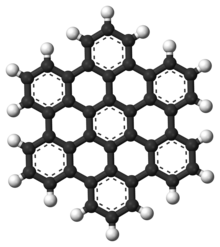Aromatic compound

Aromatic compounds or arenes usually refers to organic compounds "with a chemistry typified by benzene" and "cyclically conjugated."[1] The word "aromatic" originates from the past grouping of molecules based on odor, before their general chemical properties were understood. The current definition of aromatic compounds does not have any relation to their odor. Aromatic compounds are now defined as cyclic compounds satisfying Hückel's Rule. Aromatic compounds have the following general properties:
- Typically unreactive
- Often non polar and hydrophobic
- High carbon-hydrogen ratio
- Burn with a strong sooty yellow flame, due to high C:H ratio
- Undergo electrophilic substitution reactions and nucleophilic aromatic substitutions[2]
Arenes are typically split into two categories - benzoids, that contain a benzene derivative and follow the benzene ring model, and non-benzoids that contain other aromatic cyclic derivatives. Aromatic compounds are commonly used in organic synthesis and are involved in many reaction types, following both additions and removals, as well as saturation and dearomatization.
Heteroarenes
[edit]Heteroarenes are aromatic compounds, where at least one methine or vinylene (-C= or -CH=CH-) group is replaced by a heteroatom: oxygen, nitrogen, or sulfur.[3] Examples of non-benzene compounds with aromatic properties are furan, a heterocyclic compound with a five-membered ring that includes a single oxygen atom, and pyridine, a heterocyclic compound with a six-membered ring containing one nitrogen atom. Hydrocarbons without an aromatic ring are called aliphatic. Approximately half of compounds known in the year 2000 are described as aromatic to some extent.[4]



Applications
[edit]Aromatic compounds are pervasive in nature and industry. Key industrial aromatic hydrocarbons are benzene, toluene, Xylene called BTX. Many biomolecules have phenyl groups including the so-called aromatic amino acids.
Benzene ring model
[edit]

Benzene, C6H6, is the least complex aromatic hydrocarbon, and it was the first one defined as such.[6] Its bonding nature was first recognized independently by Joseph Loschmidt and August Kekulé in the 19th century.[6] Each carbon atom in the hexagonal cycle has four electrons to share. One electron forms a sigma bond with the hydrogen atom, and one is used in covalently bonding to each of the two neighboring carbons. This leaves six electrons, shared equally around the ring in delocalized pi molecular orbitals the size of the ring itself.[5] This represents the equivalent nature of the six carbon-carbon bonds all of bond order 1.5. This equivalency can also explained by resonance forms.[5] The electrons are visualized as floating above and below the ring, with the electromagnetic fields they generate acting to keep the ring flat.[5]
The circle symbol for aromaticity was introduced by Sir Robert Robinson and his student James Armit in 1925 and popularized starting in 1959 by the Morrison & Boyd textbook on organic chemistry.[7] The proper use of the symbol is debated: some publications use it to any cyclic π system, while others use it only for those π systems that obey Hückel's rule. Some argue that, in order to stay in line with Robinson's originally intended proposal, the use of the circle symbol should be limited to monocyclic 6 π-electron systems.[8] In this way the circle symbol for a six-center six-electron bond can be compared to the Y symbol for a three-center two-electron bond.[8]
Benzene and derivatives of benzene
[edit]
Benzene derivatives have from one to six substituents attached to the central benzene core.[2] Examples of benzene compounds with just one substituent are phenol, which carries a hydroxyl group, and toluene with a methyl group. When there is more than one substituent present on the ring, their spatial relationship becomes important for which the arene substitution patterns ortho, meta, and para are devised.[9] When reacting to form more complex benzene derivatives, the substituents on a benzene ring can be described as either activated or deactivated, which are electron donating and electron withdrawing respectively.[9] Activators are known as ortho-para directors, and deactivators are known as meta directors.[9] Upon reacting, substituents will be added at the ortho, para or meta positions, depending on the directivity of the current substituents to make more complex benzene derivatives, often with several isomers. Electron flow leading to re-aromatization is key in ensuring the stability of such products.[9]
For example, three isomers exist for cresol because the methyl group and the hydroxyl group (both ortho para directors) can be placed next to each other (ortho), one position removed from each other (meta), or two positions removed from each other (para).[10] Given that both the methyl and hydroxyl group are ortho-para directors, the ortho and para isomers are typically favoured.[10] Xylenol has two methyl groups in addition to the hydroxyl group, and, for this structure, 6 isomers exist.[citation needed]
- Representative arene compounds
Arene rings can stabilize charges, as seen in, for example, phenol (C6H5–OH), which is acidic at the hydroxyl (OH), as charge on the oxygen (alkoxide –O−) is partially delocalized into the benzene ring.
Non-benzylic arenes
[edit]Although benzylic arenes are common, non-benzylic compounds are also exceedingly important. Any compound containing a cyclic portion that conforms to Hückel's rule and is not a benzene derivative can be considered a non-benzylic aromatic compound.[5]
Monocyclic arenes
[edit]Of annulenes larger than benzene, [12]annulene and [14]annulene are weakly aromatic compounds and [18]annulene, Cyclooctadecanonaene, is aromatic, though strain within the structure causes a slight deviation from the precisely planar structure necessary for aromatic categorization.[11] Another example of a non-benzylic monocyclic arene is the cyclopropenyl (cyclopropenium cation), which satisfies Hückel's rule with an n equal to 0.[12] Note, only the cationic form of this cyclic propenyl is aromatic, given that neutrality in this compound would violate either the octet rule or Hückel's rule.[12]
Other non-benzylic monocyclic arenes include the aforementioned heteroarenes that can replace carbon atoms with other heteroatoms such as N, O or S.[5] Common examples of these are the six-membered pyrrole and five-membered pyridine, both of which have a substituted nitrogen[13]
Polycyclic aromatic hydrocarbons
[edit]
Polycyclic aromatic hydrocarbons, also known as polynuclear aromatic compounds (PAHs) are aromatic hydrocarbons that consist of fused aromatic rings and do not contain heteroatoms or carry substituents.[14] Naphthalene is the simplest example of a PAH. PAHs occur in oil, coal, and tar deposits, and are produced as byproducts of fuel burning (whether fossil fuel or biomass).[15] As pollutants, they are of concern because some compounds have been identified as carcinogenic, mutagenic, and teratogenic.[16][17][18][19] PAHs are also found in cooked foods.[15] Studies have shown that high levels of PAHs are found, for example, in meat cooked at high temperatures such as grilling or barbecuing, and in smoked fish.[15][16] They are also a good candidate molecule to act as a basis for the earliest forms of life.[20] In graphene the PAH motif is extended to large 2D sheets.[21]
Reactions
[edit]Aromatic ring systems participate in many organic reactions.
Substitution
[edit]In aromatic substitution, one substituent on the arene ring, usually hydrogen, is replaced by another reagent.[5] The two main types are electrophilic aromatic substitution, when the active reagent is an electrophile, and nucleophilic aromatic substitution, when the reagent is a nucleophile. In radical-nucleophilic aromatic substitution, the active reagent is a radical.[22][23]
An example of electrophilic aromatic substitution is the nitration of salicylic acid, where a nitro group is added para to the hydroxide substituent:

Nucleophilic aromatic substitution involves displacement of a leaving group, such as a halide, on an aromatic ring. Aromatic rings usually nucleophilic, but in the presence of electron-withdrawing groups aromatic compounds undergo nucleophilic substitution. Mechanistically, this reaction differs from a common SN2 reaction, because it occurs at a trigonal carbon atom (sp2 hybridization).[24]
Hydrogenation
[edit]Hydrogenation of arenes create saturated rings. The compound 1-naphthol is completely reduced to a mixture of decalin-ol isomers.[25]
The compound resorcinol, hydrogenated with Raney nickel in presence of aqueous sodium hydroxide forms an enolate which is alkylated with methyl iodide to 2-methyl-1,3-cyclohexandione:[26]
Dearomatization
[edit]In dearomatization reactions the aromaticity of the reactant is lost. In this regard, the dearomatization is related to hydrogenation. A classic approach is Birch reduction. The methodology is used in synthesis.[27]

See also
[edit]- Aromatic substituents: Aryl, Aryloxy and Arenediyl
- Asphaltene
- Hydrodealkylation
- Simple aromatic rings
- Rhodium-platinum oxide, a catalyst used to hydrogenate aromatic compounds.
References
[edit]- ^ "Aromatic". IUPAC GoldBook. Retrieved 2023-11-06.
- ^ a b Smith, Michael B.; March, Jerry (2007), Advanced Organic Chemistry: Reactions, Mechanisms, and Structure (6th ed.), New York: Wiley-Interscience, ISBN 978-0-471-72091-1
- ^ IUPAC. Compendium of Chemical Terminology, 2nd ed. (the "Gold Book"). Compiled by A. D. McNaught and A. Wilkinson. Blackwell Scientific Publications, Oxford (1997). Online version (2019-) created by S. J. Chalk. ISBN 0-9678550-9-8. https://doi.org/10.1351/goldbook.
- ^ Balaban, Alexandru T.; Oniciu, Daniela C.; Katritzky, Alan R. (2004-05-01). "Aromaticity as a Cornerstone of Heterocyclic Chemistry". Chemical Reviews. 104 (5): 2777–2812. doi:10.1021/cr0306790. ISSN 0009-2665. PMID 15137807.
- ^ a b c d e f g h i j k l Klein, David R. (2017). Organic Chemistry (3rd ed.). John Wiley & Sons. ISBN 9781119444251.
- ^ a b "Benzene | Definition, Discovery, Structure, Properties, & Uses | Britannica". www.britannica.com. Retrieved 2023-11-06.
- ^ Armit, James Wilson; Robinson, Robert (1925). "CCXI.—Polynuclear heterocyclic aromatic types. Part II. Some anhydronium bases". J. Chem. Soc., Trans. 127: 1604–1618. doi:10.1039/CT9252701604. ISSN 0368-1645.
- ^ a b Jensen, William B. (April 2009). "The Origin of the Circle Symbol for Aromaticity". Journal of Chemical Education. 86 (4): 423. Bibcode:2009JChEd..86..423J. doi:10.1021/ed086p423. ISSN 0021-9584.
- ^ a b c d "16.5: An Explanation of Substituent Effects". Chemistry LibreTexts. 2015-05-03. Retrieved 2023-12-03.
- ^ a b "Cresol - an overview | ScienceDirect Topics". www.sciencedirect.com. Retrieved 2023-12-03.
- ^ "What does "aromatic" really mean?". Chemistry LibreTexts. 2013-10-02. Retrieved 2023-11-06.
- ^ a b "What does "aromatic" really mean?". Chemistry LibreTexts. 2013-10-02. Retrieved 2023-11-29.
- ^ "4.2: Covalent Bonds". Chemistry LibreTexts. 2020-07-30. Retrieved 2023-11-06.
- ^ Fetzer, John C. (2007-04-16). "THE CHEMISTRY AND ANALYSIS OF LARGE PAHs". Polycyclic Aromatic Compounds. 27 (2): 143–162. doi:10.1080/10406630701268255. ISSN 1040-6638. S2CID 97930473.
- ^ a b c "Polycyclic Aromatic Hydrocarbons – Occurrence in foods, dietary exposure and health effects" (PDF). European Commission, Scientific Committee on Food. December 4, 2002. Archived (PDF) from the original on 2022-10-09.
- ^ a b Larsson, Bonny K.; Sahlberg, Greger P.; Eriksson, Anders T.; Busk, Leif A. (July 1983). "Polycyclic aromatic hydrocarbons in grilled food". Journal of Agricultural and Food Chemistry. 31 (4): 867–873. doi:10.1021/jf00118a049. ISSN 0021-8561. PMID 6352775.
- ^ Scientific Opinion of the Panel on Contaminants in the Food Chain on a request from the European Commission on Marine Biotoxins in Shellfish – Saxitoxin Group. The EFSA Journal (2009) 1019, 1-76.
- ^ Keith, Lawrence H. (2015-03-15). "The Source of U.S. EPA's Sixteen PAH Priority Pollutants". Polycyclic Aromatic Compounds. 35 (2–4): 147–160. doi:10.1080/10406638.2014.892886. ISSN 1040-6638.
- ^ Thomas, Philippe J.; Newell, Emily E.; Eccles, Kristin; Holloway, Alison C.; Idowu, Ifeoluwa; Xia, Zhe; Hassan, Elizabeth; Tomy, Gregg; Quenneville, Cheryl (2021-02-01). "Co-exposures to trace elements and polycyclic aromatic compounds (PACs) impacts North American river otter (Lontra canadensis) baculum". Chemosphere. 265: 128920. doi:10.1016/j.chemosphere.2020.128920. ISSN 0045-6535.
- ^ Ehrenfreund, Pascale; Rasmussen, Steen; Cleaves, James; Chen, Liaohai (June 2006). "Experimentally Tracing the Key Steps in the Origin of Life: The Aromatic World". Astrobiology. 6 (3): 490–520. Bibcode:2006AsBio...6..490E. doi:10.1089/ast.2006.6.490. ISSN 1531-1074. PMID 16805704.
- ^ Wang, Xiao-Ye; Yao, Xuelin; Müllen, Klaus (2019-09-01). "Polycyclic aromatic hydrocarbons in the graphene era". Science China Chemistry. 62 (9): 1099–1144. doi:10.1007/s11426-019-9491-2. hdl:21.11116/0000-0004-B547-0. ISSN 1869-1870. S2CID 198333072.
- ^ "22.4: Electrophilic Aromatic Substitution". Chemistry LibreTexts. 2014-11-26. Retrieved 2023-11-29.
- ^ "16.7: Nucleophilic Aromatic Substitution". Chemistry LibreTexts. 2015-05-03. Retrieved 2023-11-29.
- ^ Clayden, Jonathan; Greeves, Nick; Warren, Stuart (2012-03-15). Organic Chemistry (Second ed.). Oxford, New York: Oxford University Press. pp. 514–515. ISBN 978-0-19-927029-3.
- ^ Meyers, A. I.; Beverung, W. N.; Gault, R. "1-Naphthol". Organic Syntheses. 51: 103; Collected Volumes, vol. 6.
- ^ Noland, Wayland E.; Baude, Frederic J. "Ethyl Indole-2-carboxylate". Organic Syntheses. 41: 56; Collected Volumes, vol. 5.
- ^ Roche, Stéphane P.; Porco, John A. (2011-04-26). "Dearomatization Strategies in the Synthesis of Complex Natural Products". Angewandte Chemie International Edition. 50 (18): 4068–4093. doi:10.1002/anie.201006017. ISSN 1433-7851. PMC 4136767. PMID 21506209.
- ^ Zheng, Chao; You, Shu-Li (2021-03-24). "Advances in Catalytic Asymmetric Dearomatization". ACS Central Science. 7 (3): 432–444. doi:10.1021/acscentsci.0c01651. ISSN 2374-7943. PMC 8006174. PMID 33791426.
External links
[edit] Media related to aromatic compounds at Wikimedia Commons
Media related to aromatic compounds at Wikimedia Commons
















